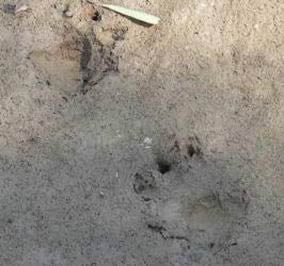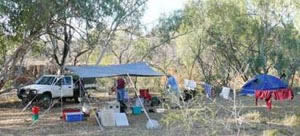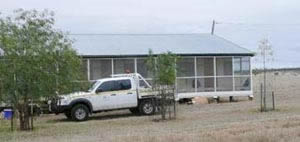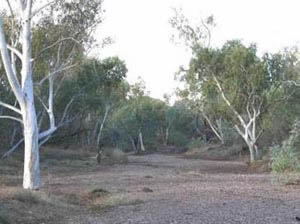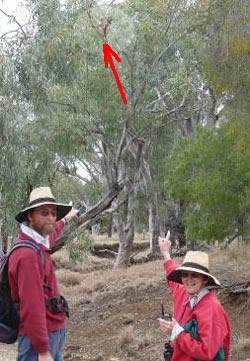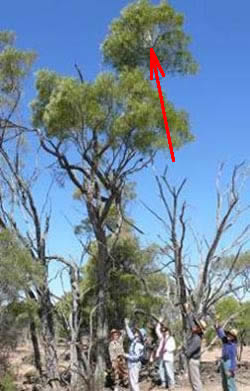| |
| Our
Newsletter is compiled by Doreen Lovett and
carefully read for errors. I'd like to place on record a vote
of thanks to Doreen for the splended job, both in content
and layout. Doreen gathers the text and photos from several
members and painstakingly puts it together. I'm sure the News
Letters bring great enjoyment to all our sponsors and readers. |
|
|
| |
|
| |
|
| |
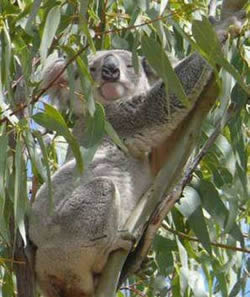 |
|
Weather
cleared during the following morning but left us with some
heavy black clay to walk through for a day or so. We spent
the next week working on the creeks and hills around the
property before John and Barbara left on the 9th September.
The second vehicle departed on the 10th September. It was
good to see Bill and Rhonda Rogers and their family after
a few years and we enjoyed their kind hospitality, excellent
company and fine cooking during our stay.
We travelled to the township of Torrens Creek (in the headwaters
of the Flinders River that drains to the Gulf of Carpentaria)
and then south following Bullock and Torrens creeks before
turning east and passing Lake Galilee and crossing the Great
Dividing Range, for the second time, near Lou Lou Station.
|
A
male koala from Iona Station |
TOP |
|
|
| |
We
camped by the roadside in silver leafed ironbark woodlands
before descending into the Burdekin basin, crossing the
Belyando River and on to Clermont on the eastern slopes
of the Drummond Range. From here we travelled across the
Fitzroy basin on the high quality sealed roads busy with
industrial traffic. We arrived in Rockhampton late that
afternoon on the 11th September.
The trip lasted 15 days and we covered 3025km – mainly
on dirt roads and in high range 4wd. We crossed five of
Australia’s major drainage basins (Fitzroy, Murray-Darling,
Lake Carpentaria and Burdekin basins) all supporting koala
populations |
|
|
| |
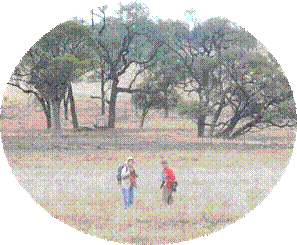 |
|
|
| The
grasslands and grassy open woodlands of Stirling Downs. Mary
and Carmen are on the way to hunt for koalas |
|
Koala
footprints at Stirling Downs |
|
|
| |
|
|
| |
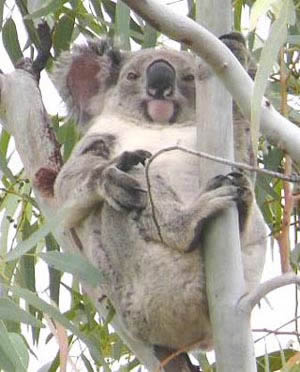 |
|
Finding
koalas and hugging trees On
Stirling Downs Jenny Skelton gave us an orientation
property tour and then guided us to a well preserved koala
skeleton. We quickly found fresh signs of koalas but walked
a lot of creek lines before finding one elusive and somewhat
ginger koala (Carmen did the spotting above Mary’s head!).
Managers Matt and Jenny Peters kindly allowed us a flying
visit to Bayrick Station. This was a short but productive
trip and within an hour Mary spotting a well camouflaged koala
in the forest canopy.
At
Iona Station Bill Rogers directed us to areas
where he had most recently seen koalas. After many kilometres
of creek-walking we found three koalas (two males, one female).
|
A
female koala from Iona Station
|
|
|
| |
But
it was not all fun. The team spent many hours measuring trees
so that the koala habitat can be described meaningfully. While
they did that I wandered amongst the trees counting the number
with koala pellets beneath them and measuring their girth
so that I can have a measure of koala activity within the
different plant communities and see if there was any size
pattern in the trees with koala pellets beneath them.
In
summary we found five koalas, collected one skeleton, measured
almost 1,500 trees and collected three dozen bags of koala
pellets. We also became experts in distinguishing koala pellets
from possum pellets and aging the koala pellets by colour,
texture and smell. The koalas used mainly river red gum and
coolabah but also gidgee, boree, napunyah (less frequently),
and rarely narrow leafed ironbark.
|
|
|
| |
The
camp on Walker Creek at Iona Station |
| |
|
| |
TOP |
Shearers'
quarters at Stirling Downs |
|
|
| |
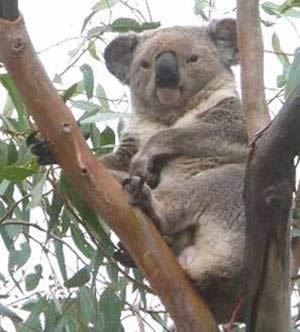 |
|
Enjoying
“the bush”
Hardly
an appropriate heading when referring to the Mitchell grasslands.
However, you cannot spend days looking on the ground for koala
pellets, in the canopy for koalas or across the paddock for
the best path without encountering the richness of the landscape.
So Barbara and John collected bird lists for both localities;
Mary admired attractive rocks that could fit well into her
garden; Carmen looked greedily at rocks, timber and abandoned
and rusty bits of metal in old property rubbish dumps that
held potential for transformation to works of art. She did
find a very little time for sketching. And then there was
the excitement of encountering unexpected fossils in the mud
and sandstone of the ancient inland sea. The undulating grasslands,
stream fringing forests, gidgee and boree woodlands and the
Spinifex and ironbark uplands all held their own appeal especially
in the warm light of sunset and sunrise. Red and grey kangaroos,
wallaroos, swamp wallabies, emus and bustards were abundant
and added to the excitement of driving on rural roads.
|
The
ginger koala from Stirling Downs |
|
| |
|
Koala
habitat at Iona Station. River red gum and coolabah fringed
the stream. Boree woodland occurred on the adjacent clay flats.
Koalas were using the gums, coolibah and boree trees immediately
adjacent to the creek |
|
|
| |
|
|
Ongoing
work
We have
brought back a large amount of data and specimens that require
analysis and interpretation. The tree measurements will be
used to develop a description of the composition and structure
of the koala habitats at each location. The koala pellets
will be analysed to discover the species of tree eaten by
the koalas. It will take some time to complete this work but
we should have some results by the new year.
We now have a better understanding of where to find the koalas
and some guess as to how far they move each night. So we are
now planning our next campaign. More on that in the future.
|
|
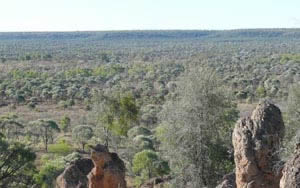 |
| |
|
| |
The
landscape of Iona Station. The homestead is just visible in
the top right |
| |
|
TOP |
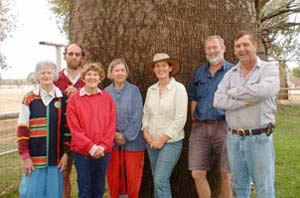 Shirley,
John, Barbara, Carmen, Jenny, Alistair, Jim
Shirley,
John, Barbara, Carmen, Jenny, Alistair, Jim |
|
Thanks
to our supporters
Jenny and Jim Skelton, Matt and Jenny Peters
and Bill and Rhonda Rogers kindly allowed
us access to their land and facilities. Dave Akers
from the Queensland Environmental Protection Agency went out
of his way to facilitate property contacts for us.
The Harvard Travellers Club provided funding
towards transport costs for this expedition. The Central
Queensland Koala Volunteers provided field equipment
and some travel costs. CQUniversity Australia
provided administrative support as well as access to laboratory
and computing facilities. The support of the team participants
in running the trip and providing resources is gratefully
acknowledged.
Alistair Melzer
18 September 2008
|
| |
|
TOP |
|
|
|
Finding
a koala in gidgee at Iona Station and Stirling Downs |
| |
|
|
| |
The
Western Trip
With our car packed to capacity, with tents,
swags etc., Alistair Mary, Shirley and I headed West to survey
the outer limits of koala habitat. It's five years since our
last visit and news of koala’s sightings have been minimal.
However we are hopeful that a colony will still exist as the
last few seasons have seen more rain.
We
went first to Tambo via Springsure - it’s a very scenic
road running along the edge of the Salvator Rosa range with
its wonderful escarpments rising up like jewels in the afternoon
light. At Tambo we met up with John and Barbara who were to
be part of our team and this is their first venture into koala
spotting. They are both avid bird watchers as is Alistair
so a list of birds was soon being compiled and the constant
exchange via radio was ‘did you see that wren, that
woodswallow’ etc. I managed to see the emus and bustards
and the odd wedgetail but anything smaller flittered past
in a blur.
We camped overnight in Tambo going on to Stirling Downs in
the morning, where we were welcomed by Jim and Jenny. We were
given the shearers' quarters to bunk in. We unpacked and made
ready to look for koalas. Koalas had been on this property
for many years but with the prolonged drought they have not
been seen for some time. The country is lovely open plains,
the grass a soft creamy ochre. The homestead yard was surrounded
by the most wonderful large bottle trees, quite a sight.
We
looked out on grassy paddocks where an occasional sheep grazed
and mobs of kangaroos hopped past, our delight in this sight
was not shared by Jim or Jenny.
On
our first inspection of the creek we found koala droppings,
recent enough to know the animals were still in the area -
this was good news to all.
Next morning we searched another creek-line and found more
evidence of koalas but again no sighting. We then set about
doing our vegetation survey work of nearest neighbouring trees
up and down the creek. This took all day and some of the neighbours,
(large coolabahs mostly) were a long way from one another.
We were dragging our legs by late afternoon. Again we are
amazed by the mobs of kangaroos hopping across the landscape.
Morning
brought the promise of rain so we headed off to another property
where koalas were frequently found and within half an hour
Mary had spotted one. Rain began falling so we hastily returned
to Stirling Downs before the rain made the black soil difficult
to traverse.
Afternoon
was spent doing vegetation survey along another creek. This
area had a lot of gidgee and some red gum so the trees were
closer. Barbara and I almost walked on a large snake, no one
else saw it and said we imagined it. The rain started in earnest
just as we finished. We were all thankful that we were in
the shearers' quarters and not in our tents as rain fell through
the night. With the vegetation work done we decided to spend
the next day Monday searching for the koala we knew must be
close by. We set out in teams and scoured the area where the
most recent evidence was found (freshest droppings). We found
it heavy going at first as the wet clay soil built up so much
on our boots. It was mid afternoon before we finally spotted
the koala just gazing down at us from a red-gum tree. We trudged
back to the homestead glad that we could report that koalas
are still living along the creek lines. A freshly baked fruit
cake was on the table for us. Jenny had baked it for us. We
all enjoyed our afternoon tea.
In the morning we packed the vehicle and farewelled Stirling
Downs and headed north west through Blackall, Barcaldine,
( where I was able to say hello to my son Bob) and Aramac
arriving in Muttaburra in time to make camp. A small storm
blew up just as we finished our meal and we all took shelter
in the amenities block until it was over.
Carmen |
|
| |
Natural Treatment
for Disease in Koalas
In Victoria,
at least, some veterinarians are applying homeopathic treatment
to stressed wildlife. According to the Flower Essence Centre
these vets believe that stress (from loss of habitat, urban
development, attacks, etc) is a big factor contributing to
the emergence and prevalence of various diseases, and perhaps
chlamydia and “AIDS” in koalas may be treatable
with a homeopathic approach. The
Flower Essence Centre says that the use of natural medicines
for treating wildlife is a new field in Australia and not
much research has been on koalas. Apparently some remedies
can be applied topically so would not interfere with a koala's
digestion.
Alistair
Melzer is not aware of any such research or treatment in Queensland
but a Google quick web search revealed 155,000 entries related
to veterinary homeopathy globally.
|
|
| |
Rendezvous with
Phascolarctos cinereus - TOP
' A Field
Guide to the Mammals of Australia' by Peter Menkhorst and
Frank Knight tells us that "the koala is an arboreal,
agile climber, descends to the ground when necessary, is mostly
solitary, its diet is almost entirely eucalypt leaves, and
it is inactive for 20 hours in 24". We
found this to be very true, when, in late August and early
September this year, we were invited to join a group of koala
researchers to see if we could find any trace of these elusive
mammals near Tambo in the south and Hughenden to the north.
Our endeavours were indeed successful for there were five
koalas located in total – four males and one female.
Our
learning experiences included deciphering koala scratch marks
on trees, recognising the difference between koala scat and
possum poo, sensing the freshness of this very excrement,
pinpointing the location of this waste product and becoming
aware of the tree preferences of this unique creature. Another
new challenge for us was the koala habitat survey (nearest
neighbours) where our knowledge of tree genera was extended
and we became “real” greenies by hugging multiple
trees.
On
the whole, the weather was kind to us – not too cold
and with two nights of welcome rain.
We
were very impressed with the professionalism and dedication
of the team with which we worked, the hospitality and generosity
of the property owners and the co-operation of the five koalas
for revealing themselves for our scrutiny.
We
wish all researchers the very best and hope their results
are most rewarding.
Barbara
and John |
|
|
| |
| |
| |
| |
| |
| |
| |
| |
| |
| |
|



